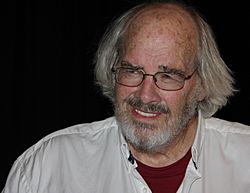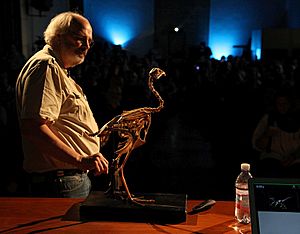Jack Horner (paleontologist) facts for kids
Quick facts for kids
Jack Horner
|
|
|---|---|

Horner in 2015
|
|
| Born | June 15, 1946 Shelby, Montana, U.S.
|
| Awards | Romer–Simpson Medal (2013) |
| Scientific career | |
| Fields | Paleontology |
| Institutions | Chapman University, Horner Science Group |
John Robert Horner (born June 15, 1946) is an American paleontologist. He is famous for discovering Maiasaura, a dinosaur that showed how some dinosaurs cared for their young.
Besides his fossil discoveries, Horner also worked on the Jurassic Park movies. He was a science advisor for the first five films. He even had a small role in Jurassic World. One of the main characters, Dr. Alan Grant, was partly inspired by him.
Horner studied at the University of Montana. He did not finish his degree because he had dyslexia, which was not diagnosed then. Later, he received an honorary doctorate degree. He retired from Montana State University in 2016. Now, he teaches at Chapman University.
Contents
Jack Horner's Early Life and Discoveries
Horner grew up near Shelby, Montana. He found his first dinosaur bone when he was just 8 years old. He studied geology and zoology at the University of Montana. He also served in the U.S. Marine Corps during the Vietnam War.
Even though he had severe dyslexia, he wrote a senior paper. This paper was about fossils found in the Bear Gulch Limestone in Montana. This site is famous for its well-preserved fossils. In 1986, the University of Montana gave him an honorary science degree. He also received the important MacArthur Fellowship award that year. In 1993, he got the Golden Plate Award.

In the mid-1970s, Horner and his partner Bob Makela made a big discovery in Montana. They found a nesting site of a new dinosaur. They named it Maiasaura, which means "Good Mother Lizard." The first bones were found by Marion Brandvold.
This discovery included the first dinosaur eggs found in the Western Hemisphere. It also had the first dinosaur embryos. This showed that some dinosaurs lived in groups, built nests, and took care of their babies. This finding made Horner's career famous. He has named several other dinosaur species. Three dinosaurs have been named after him: Achelousaurus horneri, Anasazisaurus horneri, and Daspletosaurus horneri.
Understanding Dinosaur Growth
Horner is well-known for his research on how dinosaurs grew. He has written many articles with other paleontologists. They studied dinosaur growth by looking at bones of different ages. This included bones from embryos to adult dinosaurs.
Horner also brought back an old idea about Tyrannosaurus rex. He suggested that T. rex might have been a scavenger (eating dead animals) instead of a hunter. This idea was popular in the news. However, Horner said he used it mainly to teach people, especially kids. He wanted to show that we should not make assumptions in science without proof.
In 2000, Horner's teams found five T. rex fossils. The next summer, they found three more. One of these was even bigger than the famous "Sue" specimen. This new fossil was 10% larger. The Museum of the Rockies now has the world's largest collection of Tyrannosaurus rex fossils. Horner is currently studying how dinosaurs developed from embryos.
Horner's Contributions and Recognition
Horner has written over 100 scientific papers and eight books. His books include Dinosaurs Under the Big Sky and a children's book called Maia: A Dinosaur Grows Up. He also wrote Dinosaur Lives, a non-fiction book about Montana dinosaurs.
In 2005, he was part of a team that found soft tissue in a T. rex fossil. Horner was the Curator of Paleontology at the Museum of the Rockies. He also taught at Montana State University. He has guided many students who became leading experts in paleontology. In 2006, Pennsylvania State University gave him an honorary doctorate.
In 2003, Horner found a fossilized tyrannosaur leg bone. From this bone, paleontologist Mary Higby Schweitzer found proteins in 2007.
In 2009, National Geographic released a film called "Dinosaurs Decoded." This film looked at Horner's research on young dinosaurs. He suggested that young dinosaurs looked very different from adults. Because of this, some young dinosaurs were mistakenly thought to be different species. Horner's research has helped to reclassify some "sub-species" of Triceratops, Pachycephalosaurus, and Tyrannosaurus. He believes that if his research continues, many known dinosaurs might be grouped under existing species.
On November 2, 2013, Horner received the Romer–Simpson Prize. This is the highest award a paleontologist can get from the Society of Vertebrate Paleontology.
When he retired from Montana State University in 2016, the MacMillan Foundation honored him. They gave $3 million to create the John R. Horner Curator of Paleontology Chair. This money helps fund the work of future paleontologists at the Museum of the Rockies.
A children's book called Jack Horner, Dinosaur Hunter! tells his life story. It talks about his childhood in Montana and his scientific work. It also mentions how he managed life with a reading disability.
The "Build a Dinosaur" Project
Horner's 2009 book, How to Build a Dinosaur: Extinction Doesn't Have to Be Forever, describes a unique plan. He wants to create a dinosaur by changing the DNA of a chicken. Horner got this idea from an early script for the movie Jurassic World.
He had been planning this book since 2005. It was originally meant to be released with Jurassic World.
In 2011, Horner started this project with a team of geneticists. He calls the animal a "chickenosaurus." By November 2014, Horner and his team had done early research on how tails develop in embryos. This research could help people with spinal problems. Research into chicken embryo tissues that guide tooth growth might also help treat human cancers. George Lucas helped fund much of this project. Horner hoped to have a living dinosaur within 10 years.
In 2015, other scientists found a way to change chicken embryo beaks back into dinosaur-like snouts. Geneticists in Chile also created embryos with dinosaur-like leg and foot bones.
See also
 In Spanish: Jack Horner para niños
In Spanish: Jack Horner para niños


